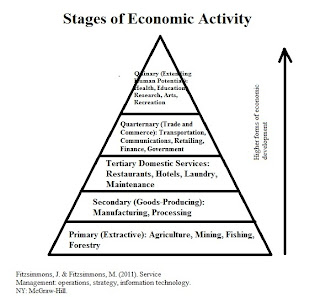Service has an important component to provide within the
national economy. Such services enhance the quality of life for many
individuals and make their day more effective. The post industrial society is
based upon the ability of people to afford and able to use such services effectively.
As society progresses from self-sustenance to shared sustenance the complexity
of infrastructure and specialized services combine to create an inter-wrapping
of networks and structure.
The development of society and the development of services are
on the same trajectory of growth. Society moved from providing extractive
services such as agriculture and mining to secondary services such as
manufacturing and processing. We are also now offering tertiary services such
as restaurants and hotels and have grasped a higher level of governmental,
financial and retailing structure. It is possible that we are moving into the quinary
age of health, education, research, arts and recreation (Fitzsimons, &
Fitzsimons, 2011).
The appropriate development and delivery of services
requires a strategy to make it effective. There should be alignment of the
service system delivery, operating strategy, service concept, and target market
segments (Sasser & Schlesinger, 1997). Each of these elements creates a
function that when working in tandem provides the highest level of value for
the customer and the potential highest level of income to the organization. Providing
customer value and earning revenue are one in the same.
One of the ways to determine whether or not an organization
is in proper alignment with its environment is to conduct a SWOT analysis. The
SWOT analysis includes the concepts of Strengths, Weaknesses, Opportunities and
Threats. Each organization has its own strengths that are unique to that
company, has weaknesses that can be improved, opportunities for expansion into
the market and threats that can damage its future sustainability.
Strategy is the ability to take the information from the
SWOT analysis, or other form of market scanning, and implement it within the
organization. This is the most difficult task of any executive that desires to
make an impact. They must make sense out of the information, honestly review
their organizations capabilities, and then implement a strategy that impacts
the entire chain of functioning throughout the organization. In the end this
change should come to an appropriate output which raises sales, reduces
expenses and improves revenue.
Fitzsimmons, J. & Fitzsimmons, M. (2011). Service Management: Operations, Strategy,
Information Technology (Seventh Edition). NY: McGraw-Hill.
Sasser, H. & Schlesinger, L. (1997). The service profit chain. NY: The Free
Press.

No comments:
Post a Comment